Canada. Part 33
Description
This section is from the book "Canada - John L. Stoddard's Lectures", by John L. Stoddard. Also available from Amazon: John L. Stoddard's Lectures 13 Volume Set.
Canada. Part 33
" The rudiments of empire here Are plastic yet and warm ; The chaos of a mighty world Is rounding into form !
" Each rude and jostling fragment soon Its fitting place shall find, - The raw material of a State, Its muscle and its mind".
It must not be supposed, however, that all parts of the great Canadian Northwest are equally productive. The regions farthest north will probably be fully developed only when the other Provinces have been well occupied. Nevertheless, the fact remains that wheat is grown successfully on the Peace River in latitude fifty-six degrees; while melons, maize, pumpkins, beans, and tomatoes are regularly raised as crops in Manitoba, and may be grown in latitude fifty-three, on the banks of the Saskatchewan. The western sections of the prairies are ideal ranching ground, for there horses and cattle can be turned out for the winter without shelter, yet will be found in good condition in the spring, having maintained themselves by eating the nutritious grass, which the dry weather of fall invariably cures to hay, and which they easily obtain by scraping through the thin, light snow.
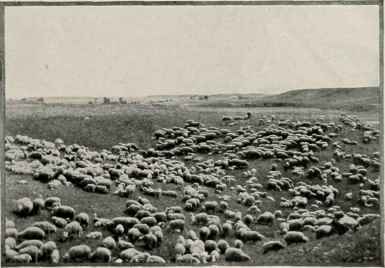
Sheep Pasture.
Accordingly, this region, now known as Alberta, was formerly the winter home of countless herds of bisons, which always came hither from the south on the approach of severe weather, and found here ample sustenance. Had they remained in a more southern latitude, where rains and thaws harden the snow to ice, they would have perished. This would have been, however, merely an anticipation of their actual fate. In vain did they obey their migratory instinct, after the arrival of the "pale face" on the scene. The Indian had hunted them for food, but could make little impression on the millions which then roamed the plains. It was reserved for "civilized" man to destroy them wantonly; partly through greed, but chiefly through a far more inexcusable love of unremunerative slaughter. Unfortunately for themselves, the bisons, as a rule, were harmless, and preferred to shun man, rather than resist him. Here, therefore, was a chance for even cowards to swell the ranks of genuine hunters and to appear as heroes. How fully they availed themselves of the opportunity is seen by the fact that they have practically exterminated the characteristic animal of North America. Not many years ago the plains were black with herds of bisons, the thunder of whose hoof-beats shook the earth. To-day, only a few poor specimens are preserved with difficulty in a zoological garden or a national park, and pointing to some heaps of whitening bones, gathered and sold for fertilizing purposes, the white man is entitled to the questionable privilege of saying, "This is my work!"
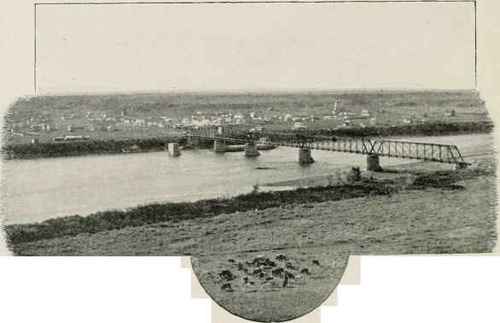
Medicine Hat, On The Saskatchewan.
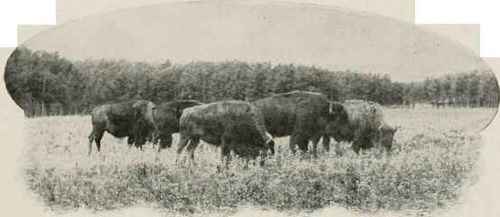
Bisons At Silver Heights, Winnipeg.
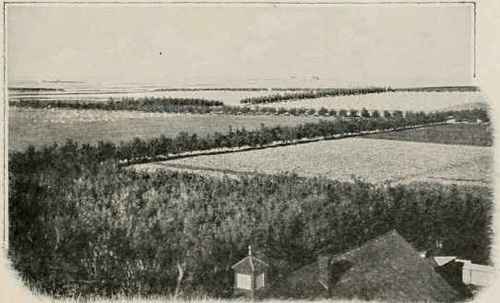
Farming Country, Assiniboia.
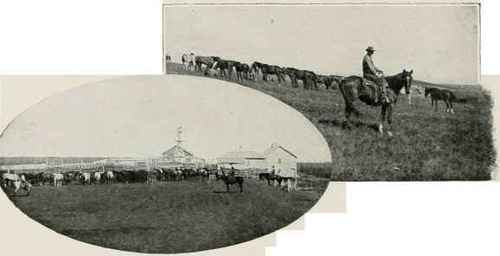
Horse Ranch At Calgary.
Cowboy.
The principal reason why Alberta and other portions of this region have so mild a climate, although one thousand miles farther north than New York City, is that the warm air currents rising from the Pacific Ocean are gradually denuded of all moisture in their passage over the Rocky Mountains, and finally descend thence on these plains as mild, dry winds, to which the Indian tribal name, "Chinook," is popularly given. These clear away the light snow by evaporation, without, however, either thawing it or leaving behind the slightest trace of dampness. Thus, in a short time after a chinook, the self-cured hay stands free again over innumerable miles of sunlit prairie -a perfect nutriment for cattle, and the food on which a billion bisons battened in the past.
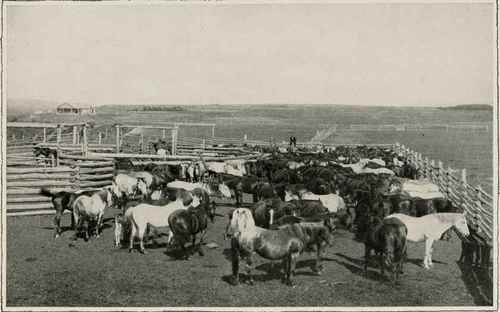
A Horse Corral.
The North American Indian would probably have long since shared the fate of his contemporary, the bison, had his skin been equally valuable for commercial purposes, or his power of resistance of as little efficacy. The aborigines of America were undoubtedly, for the most part, cruel and degraded, but they frequently exhibited noble qualities, which, had they been reciprocated by the white men, might have alleviated, to some extent, the long, sad tragedy of this western world. This, at least, must be said for the Indians - they were not servile. They could not be enslaved. As Professor Booker T. Washington has pointed out, when the first slaves were brought from Africa to Virginia, the forests of this country swarmed with people of another colored race. Why, therefore, did the whites assume the trouble and expense of capturing negroes in a distant continent, and bringing them across the ocean, when they had thousands of dark-skinned savages close at hand? The answer is that the Indians would not submit to slavery. The attempt was made, but the red men would not, and could not, bear captivity and toil, and died thus in large numbers. Professor Washington thinks that in yielding to the inevitable, and patiently enduring slavery, the negro showed the greater wisdom, for he has won thereby in the end a civilization vastly superior to that of the Indian. While this is true, and while we must respect the only race which has ever been able to survive, and even to increase, as well as to acquire a great commercial and economic value, when rendered subject to the white man, still no one can refuse a melancholy tribute of admiration to those Indians who, feeling that their native land was being taken ruthlessly from them, and having experienced from the white men countless acts of cruelty and treachery, rejected scornfully any further overtures, and either fought their pale-faced conquerors to the last, or else, retreating to some almost inaccessible solitude, silently passed away. Their very name recalls the disappointed dream of those who have supplanted them, for the title "Indian" was bestowed upon them by the first explorers who, in their effort to discover a northwestern ocean route to Asia, thought that these natives were inhabitants of India. The race has vanished almost as completely as the dream.
Continue to:


